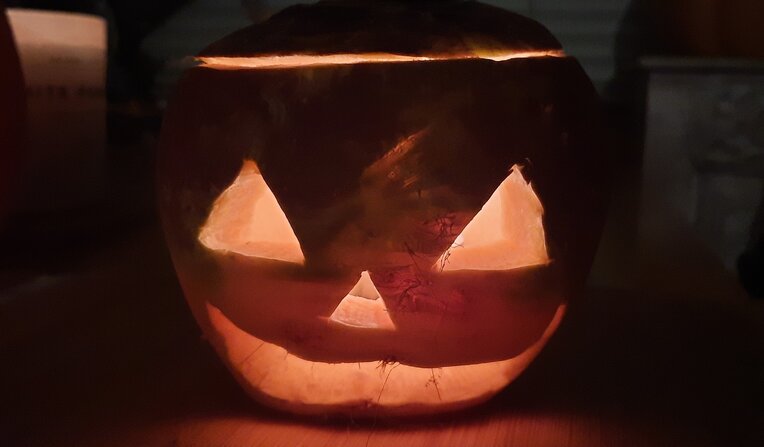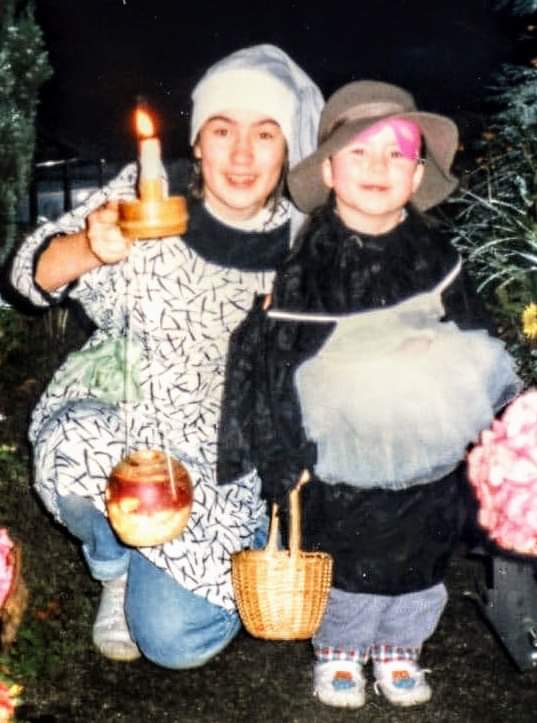Customs and Traditions of Samhain and Halloween

We are entering the dark time of the year, the womb of the Dark Mother. Can you feel it? It is the time of retreat into the cave, where Cerridwen stirs Her cauldron of transformation and elemental Goddesses like the Cailleach make their presence felt. In the days leading up to Halloween and the old Celtic festival of Samhain, we are used to the familiar sight of carved pumpkins, but not so very long ago it would be turnip lanterns, or ‘tumshie lanterns’ as they are known in Scotland, adorning doorways and windows. In fact, further back still, any sort of root vegetable was worthy of a carved face and a candle placed inside it, while the innards of these newly-created vegetable gods and guardians, would be added to the cooking pot to feed the family as soups and stews.
The excitement that is elicited from the scent of burnt tumshie, which inevitably happens when the tealight inside begins to heat the lid of the lantern, has never quite left me. Even now, it takes me back to the Octobers of my childhood with homemade Halloween costumes and guising through the streets; my younger self practising a poem or joke under my breath, before the neighbour’s door was knocked and my party piece was performed.

Tumshie lanterns and guising are perhaps the most recent and widely remembered aspects of October folk traditions in the British Isles, but the ethnographic record is rich in other customs of this time when the veil is thinning and people would draw in for the year. Samhain or ‘summer’s end’ would indeed have been the time when the world of our ancestors would crine in (a bit like a week old tumshie lantern, whose flesh has begun to shrink). The sheilings would have been closed up for the year and the animals brought down from the summer pastures, high in the hills. In earlier times, the last of the seasonal fairs had ended and people knew they would not see their more distant relatives and friends until the next spring. Journeys far afield during the winter months would not be undertaken unless necessary.
Wise Women, Divination, the Cailleach and Poetry
However, the dark half of the year did not mean isolation for our ancestors. I have noticed that many of the customs and games played on Halloween in different parts of Scotland, were communal in nature. Perhaps most significantly for those of us who are interested in the ways of the wise women and elders, the gatherings at this time of year would often take place in the home of the old woman of the village – for example, in Shetland, young people congregated to witness divination practices of these wise women. Alec Laurenson described this memory to the folk collector, Alan Bruford, in 1974.[1]
Predictably, as befits the time of year when the veil is thin, divination was popular, with young people keen to know who they would marry; after all, knowledge and hope in a secure future with a husband or wife was of utmost importance!
In an interview in 1961, Finlay Finlayson from Braes, Skye, recounts his memories of the early 20th century to Anne Ross. He remembered a sheepskin or cowskin, which would be carried from house to house at Halloween. A rhyme was chanted, after which bannocks, bread and other food was given. He fondly remembers the party afterwards during which games such as ducking for apples and fortune-telling would be played.[2] The mention of cowskin is interesting because it reminds me of the etymology of Cailleach – the ‘old woman’ in Irish and Scottish Gaelic culture. She was the ‘Veiled One’ or ‘Cloaked One’, associated with winter, wildness, harsh weather and horned beasts.[3] Was the Cailleach being invited in or kept sweet in anticipation of the coming months?
While there is no connection between the Cailleach and Cerridwen (they are definitely different Goddesses!), they do share a love of a good cauldron. The Cailleach is said to usher in winter on the west coast of Scotland by washing her great plaid in the Gulf of Corryvreckan (Coire Bhreacain means ‘whirlpool or cauldron of the plaid’).[4] Likewise, in more modern times, it seems that the Cailleach is a forthright and sometimes hard-to-please muse-like figure of the Gaelic poets, in much the same way as the later Welsh bards derided Cerridwen if their poetry was not going the way they wanted. The 18th century Scottish Gaelic poet, William Ross, imagined the Cailleach as an inner literary critic in his poem ‘Oran eadar am Bàrd agus Cailleach-mhilleadh-nan-dàn’ (‘Exchange of Verses between the Poet and the Hag-who-spoils-poems’).[5]
Connecting as Communities for the Mundane and the Magickal
So, we can see that Samhain was a time of divination when people braced themselves for what was to come. Customs had to be fun when you were staring ahead to the oncoming Goddess of Winter. These traditions may be receding further into our distant past, but are our concerns and needs really that different to those of our ancestors? We are about to enter into one of the most uncertain winters in recent memory. People are worried about rising costs, fuel bills and food shortages. There is a feeling of lack for many.
For those of us with one foot in the otherworld and one foot planted firmly in the dark earth of this world, we can feel this keenly. There will always be the temptation to close our doors and retreat inwards. But that will solve nothing and it was not the way of our foremothers and forefathers. As community leaders and guides, in the coming months, we need to light our metaphorical tumshie lanterns in our windows as a form of welcome to those out in the cold. We can encourage community connection, urging others to come together, to cook together and share more than just food… stories, songs, shared experiences and conversation are all forms of nourishment to many. It is possible to merge the practical with the magical and find the spark that will take our communities through these dark months. And maybe, just maybe, we can look into the dancing flames of the October and November fires and divine a better way to live.
Blessed Be and lang may your tumshies burn!
Elan Clark, Priestess of Cerridwen
West Lothian, Scotland

Instagram: @elan_and_the_hare
Elan is a scholar, writer and editor in the field of Celtic Studies. She has a PhD in Gaelic poetry and teaches university classes in Celtic culture and literature.
References:
[1] See tobarandualchais.co.uk/track/72782?l=en
[2] See tobarandualchais.co.uk/track/65192?l=en
[3] Gearóid Ó Crualaoich, The Book of the Cailleach: Stories of the Wise-woman Healer (Cork: Cork University Press, 2003).
[4] Marian F. McNeill, The Silver Bough: A Calendar of Scottish National Festivals, Candlemas to Harvest Home, (Glasgow: William MacLellan, 1959) pp, 20-21.
[5] Derick S. Thomson, Gaelic Poetry in the Eighteenth Century: A Bilingual Anthology (Aberdeen: Association for Scottish Literary Studies) pp. 161-167.
Tumshie image by Elan